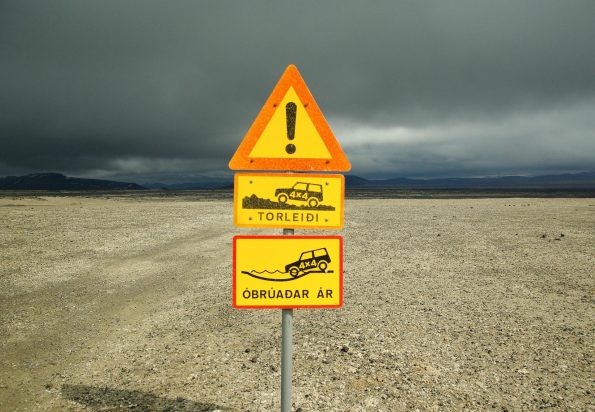Road signs are a mixture of symbols and words. In Australia those words are in English. However, there are two groups of people who struggle to understand written English:
- Native-born people with low literacy
- Migrants and visitors with poor English skills or dyslexia
Low literacy
Around 2.4 million Australians aged 15-74 years have literacy levels at or below level 1 out of 5. While people at this level might be able to hold a perfectly comprehensible conversation, reading is not their strong point; reading a sign while driving at 100km/h adds extra complexity. We are aware (anecdotally) of drivers in certain industries that struggle to read. They may have got their licence 40 years ago when there was no graduated driver licence system with a written theory test.
Migrants and visitors
Most migrants and many tourists have very good English skills. However, reading signs in English at high speed is difficult if your native language uses totally different characters. With over a million visitors from North East Asian countries such as China, Japan and South Korea, many of whom rent vehicles, there are large numbers of people on the roads who have to rely on reading the road ahead rather than reading the signs.
Australia’s road signs
We have a surprising number of signs which are just written words with no symbol, for example:
- Give way to pedestrians
- Left lane must exit
- Left turn on red permitted after stopping
- No overtaking or passing
- Road work ahead.
A person who can’t read signs like this have to rely on what they can see on the road and that means they have less time to adjust their speed or position and prepare for a hazard.
Countries which are exempt from taking a licence test
Take a look at the following list of countries. People with a driver licence from one on of these countries do not have to take an Australian driver knowledge test or practical test to exchange their full driver licence for a full Australian licence (only applies for cars and motorbikes, not heavy vehicles).
- Austria
- Belgium
- Bosnia and Herzegovina
- Canada
- Croatia
- Denmark
- Finland
- France
- Germany
- Greece
- Guernsey
- Ireland
- Isle of Man (licences issued since 1 April 1991)
- Italy
- Japan
- Jersey
- Luxembourg
- Malta (licences issued or renewed since 2 January 2004)
- Netherlands
- New Zealand, (except for paper licences)
- Norway
- Portugal
- Singapore
- Spain
- Sweden
- Switzerland
- United Kingdom
- United States of America
18 of those countries do not speak English as the main language.
Furthermore, if the driver is over 25, the following countries are included.
- Bulgaria
- Republic of Cyprus
- Czech Republic
- Estonia
- Hong Kong (Important: Hong Kong licence holders must have held a Hong Kong licence for a minimum period of 12 months)
- Hungary
- Latvia
- Lithuania
- Poland
- Romania
- Serbia
- Slovakia
- Slovenia
- South Africa
- South Korea (Republic of Korea)
- Taiwan
14 of the 16 countries listed above don’t have English as their main language and many of them use non-Roman characters in their alphabet.
Consequences of not being able to read road signs
Arguably the majority of driving is not dependent on being able to read road signs; drivers can generally figure out what’s going on by watching the movement of other traffic. However, it does increase risk and it leads to some scenarios where people’s lives could be put in danger. For example:
- Ford – indicates there will be standing water on the road which is usually very difficult to see at night. Ploughing into it at high speed can cause a driver to lose control.
- Reduce speed now – some kind of intersection is coming up and there would be the risk of not being able to stop in time
- Prepare to stop – roadworks are ahead and a driver may need to stop
Health and safety obligations
Companies have an obligation to help keep their drivers safe. Safe Work Australia estimates as many as 65% of road fatalities involve people driving for work. Companies can reduce their risk by providing literacy education to their workers that drive; it will probably also improve the workers’ general performance, too.
The Fleet Driver Plan run by our sister site, DT Driver Training, works for drivers in Australia and New Zealand to help companies comply with their obligations under health and safety at work legislation by using engaging modules for driver education.
Companies that are aware of drivers with low literacy should ensure that those drivers recognise road signs if part of their job is driving.
Driver obligations
Drivers are responsible for the safety of themselves and other road users. The minimum that a driver should be able to do is read and understand all of Australia’s English-language road signs, regardless of where they are from and what their first language is.
We may reach a point that a critical mass of immigrants or visitors to Australia require signs in their language or for our signs to be more visual. Other countries with large numbers of tourists and uncommon languages do this, such as Israel whose trilingual signs appear in Hebrew, Arabic and English, Wales where signs and road markings are mandated to be in Welsh and English, and Iceland whose signs are usually graphical and are occasionally accompanied by English language panels. In the case of Israel and Wales, the languages are the official languages, but in the case of Iceland the majority of the population speaks English and there are more English-speaking tourists to the island each year than there are residents of Iceland itself.

Iceland’s road signs are visual where there’s danger
